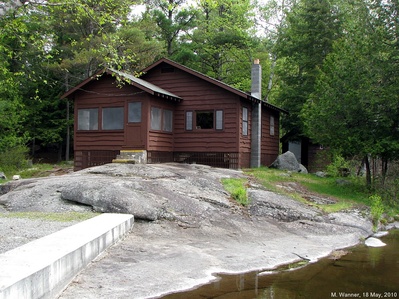 The upper locks, 2010 There are two sets of locks on the Saranac River that make passage possible from Middle Saranac Lake through Lower Saranac Lake to Lake Flower without a carry.
The upper locks, 2010 There are two sets of locks on the Saranac River that make passage possible from Middle Saranac Lake through Lower Saranac Lake to Lake Flower without a carry.
Adirondack Daily Enterprise Weekender, April 2, 1985
Evolution of the locks joining the Saranac River Locks
As the weather begins to turn warm and the ice starts to clear from Lake Flower, thoughts turn to boating along the Saranac River.
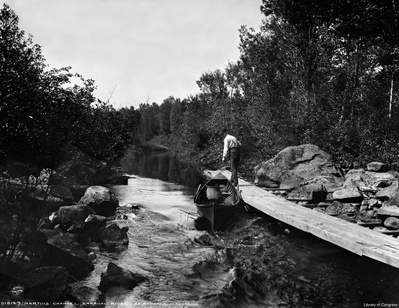 Dragging a guide boat through Martin's channel (between 1900 and 1906)
Dragging a guide boat through Martin's channel (between 1900 and 1906)
Boaters have come to rely on the lower lock, which connects Lake Flower with Lower Saranac Lake. The lock, which has been undergoing repairs since the fall, is scheduled to reopen to boating traffic by July 4, just in time for the summer tourist season, the Department of Environmental Conservation has announced.
So this might be an appropriate time to review the history of the lock systems in the Saranac River.
At the outlet of Upper Saranac Lake the infant river tumbles over a 35 foot drop. This was the site of Bartlett's Lodge where a carry was necessary to circumvent the rapids.
Downstream the river is shallow and sluggish at its entry into Round Lake. Although today this body of water is officially named Middle Saranac Lake, to the old guides and senior residents it will always be Round Lake.
 Bertrand H. Gray in Scout, at the lower locks of the Saranac River (Detroit Publishing Co., between 1900 and 1910).
Bertrand H. Gray in Scout, at the lower locks of the Saranac River (Detroit Publishing Co., between 1900 and 1910).
Leaving from the eastern end of the lake the river twists and turns through a tortuous northerly course for a little more than a mile where it parts to circle a small island.
It was here in 1877 that William F. Martin decided to make the first navigational improvement in the river's history. Both sides of the little island presented rocks and rapids known as the Middle Falls. Although the drop was three feet, the combination of rocks and flow made a carry necessary. Martin built a dam across one channel and blasted rocks out of the other so that the diverted water afforded a passageway for his steamboat, the Water Lily.
Later a group of disgruntled guides, who felt that the little steamer was usurping their business, dynamited the dam so that Martin could no longer carry passengers from his hotel to Bartlett's. In 1890 the state appropriated $5,000 for the improvement of the channel.
The state also decided that a set of locks be built. The top ones were known as the upper locks and a set between the Lower Lake and Lake Flower became the lower locks.
 Guides run the rapids, before the locks were built. (Seneca Ray Stoddard, undated)
Guides run the rapids, before the locks were built. (Seneca Ray Stoddard, undated)
At the upper lock (although the singular version is correct, for some reason the plural term "locks" has always been applied to these two locations) the left hand channel, looking downstream, was selected as the better of the two courses. The side walls were made of concrete and at each end was a double gate with a single wicket each.
Once the gates were closed the wickets acted as ports to let water in or out. A lock tender was on duty during the boating season.
During the 1930's Robert "Poker" Ryan served in this capacity and among his many regulars was the team of Fred Rice and Martha Reben on their treks to Weller Pond which resulted in Martha's best seller The Healing Woods. Ryan remembers their initial trip when Martha had to be transported on a mattress while reclining in Fred's boat. In her book she tells of her miraculous recovery.
From the upper locks the river continues north for a half mile and then turns sharply east to enter into the Lower Lake at its western end. Halfway down the lake the river exits opposite Bluff Island at First Pond, passes under the state bridge into Second Pond, and then narrows down once again as it approaches the site of the lower locks.
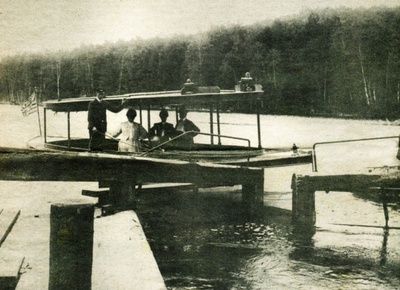 A motor launch entering the Lower Locks from upstream, early 1900s. Adirondack Daily Enterprise Weekender, April 2, 1985
A motor launch entering the Lower Locks from upstream, early 1900s. Adirondack Daily Enterprise Weekender, April 2, 1985
In the old days the river rushed over a rocky drop of five feet which also made a carry necessary for all boat traffic. As the growing popularity of motor launches evolved during the early 1900's boat owners from Lake Flower eagerly looked for a means to make navigation possible to the more inviting waters of Lower Saranac Lake, where a greater variety and wider expanse awaited.
The first attempt to conquer the falls was a rather cumbersome contraption consisting of a hand operated windlass with a cable to draw the boat up or lower it down. The state replaced that contraption with another set of locks similar to the upper locks but larger in size. A dam was built extending from the south shore to the concrete wall of the lock. At the shore end of the dam a waste gate was installed to control the water level.
Now boats up to 30 feet in length could navigate from Lake Flower to the Lower Lake and from there to Round Lake and Bartlett's Carry.
Still the original river channel turned and swerved in a serpentine course.
The old guides knew where the channel provided safe water but inexperienced motor boaters frequently hit rocks and stumps. Later the Saranac Boat and Waterways Club marked the channel with wooden arrows and color coded rocks.
The building of the lower locks opened the way for a new bit of local industry. Several of the village entrepreneurs decided to go into the tour boat business. One of the first to announce was Fred Colbath, who operated from his boathouse at 15 River Street. His advertisement read as follows: "A twenty eight mile trip to Lower Saranac with stops at the Algonquin and Ampersand docks. Round trip $1.10. One way 75¢." He named his craft the Ampersand and provided high backed willow chairs for all aboard.
 Campers enter the Lower Locks, 1960s. Courtesy of Keith Gorgas.
Campers enter the Lower Locks, 1960s. Courtesy of Keith Gorgas.
Freeman Baker built his own tour boat, the Bluebird, in the shop now occupied by Keough Marine [Fogarty's Lake Flower Marina, in 2010]. Capt. Thomas ran his passenger boat from the Thomas Boat Landing on River Street adjacent to Prescott Park. One of his trips ended in tragedy above the lower locks. His son had fallen overboard and Capt. Thomas jumped after him. Passengers rescued the boy, but the elder Thomas was drowned.
The tour boat business is carried on by Doyle and MacDowell but their boat is limited to cruise only as far as the locks.
Because of its draft the owners believe it would be imprudent to operate in the shallows above the locks. If the state would agree to a little dredging and rock removal where Cold Brook enters the river, this tour boat could extend its operation into the more scenic reaches of Lower Saranac Lake.
 The Lower Locks from down stream, 2011
The Lower Locks from down stream, 2011
The current repair and overhaul at the lower locks is not its first face lifting. Several times in the past years equipment has been updated and a pressure type concrete called gunite applied to sidewalls and abutments to shore up the structure and stop leaks.
The first major change came in 1970 when electric power was brought to the locks by submarine cable, and compressed air now opened and closed the gates and wickets.
The same "Poker" Ryan, who was stationed at the upper locks some 35 years earlier, was now lock tender at the lower locks: One day during Ed Lamy's tenure as a lock tender a wealthy lady passenger in a boat being locked through somehow managed to drop a valuable diamond ring overboard. She begged Ed to find it. Ed feared that if he opened the wickets to drain the lock, the ring might be washed downstream and lost forever, but by keeping both gates and wickets closed the ring would surely remain in the confines of the lock.
In another boat waiting to enter the locks were a couple of young men whom Ed knew. He enlisted their services to dive for the ring. After repeated dives the boys brought up a book, three watches, a set of false teeth and finally the missing diamond ring.
Ed later claimed that he lived all winter on the generous reward received from the grateful lady.
Malone Palladium, May 15, 1890
Hon. W. G. Stevens has completed his second year of service in the Assembly, with added honor to himself and with entire satisfaction to his constituents. His success in securing the appropriation for a new armory the past winter, with the carrying through both Houses of a grant of $5,000 for building a lock between Lower Saranac Lake and Round Lake, [the Upper locks] in order to permit the passage of a small steam yacht between the two waters, shows his adaptability for promoting local measures. We do not commonly believe in grants of public moneys for the improvement of insignificant streams, but our Adirondack region has become so largely the resort of the people of the entire State that whatever increases its accessibility is of real public benefit, and this appropriation constitutes a fair exception to the rule…
Essex County Republican, May 11, 1900
The sum of $6000 was appropriated by the Legislature of 1900 for building a lock in the dam at Saranac Lake to allow the passage of steamers into Lower Saranac Lake. This will allow steamers plying on the lake to run to the village. [Lower locks]
Chateaugay Record and Franklin County Democrat, June 8, 1900
The appropriation of $6,000 by the state for the construction of a lock in the Saranac river at the state dam, about six miles from the village of Saranac Lake, will allow steam launches to pass from the village of Saranac Lake to the Lower Saranac Lake. [Lower locks] It is believed that the level of the lake will be raised about 15 inches. The dam primarily is being constructed for the benefit of the lumbering Interests. An attempt was once made to construct a lock in the Saranac River between the Lower and Middle (Round) Saranac Lakes. [Upper locks] This was a failure, and the ruins of the unfinished lock stand as a warning to the attempt. Some enthusiastics believe that launch navigation will be attained between the Lower and Middle Saranac Lakes, but much dredging and an expensive lock would be necessary, and the results would not be especially beneficial.
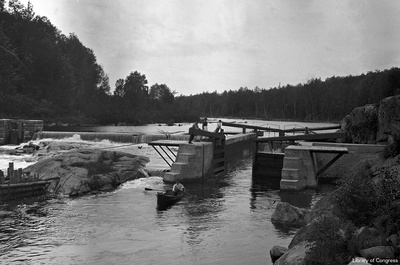 Lower Locks, 1902 (William Henry Jackson)Gouverneur Northern Tribune, July 10, 1901
Lower Locks, 1902 (William Henry Jackson)Gouverneur Northern Tribune, July 10, 1901
The new lock at the dam in Saranac Lake River, six miles above Saranac village, has been completed, and small boats locked through from Saranac to Lower Saranac Lake. [Lower locks] The river in several places is very shallow, and will probably not be dredged out this year as the appropriation has been exhausted. With another appropriation next year for dredging the river, large boats can pass through.
Malone Palladium, May 3, 1906
Mr. Matthews, working in conjunction with Attorney-General Mayer, has succeeded also in getting into the supply bill an appropriation of $5,000 for building a lock and dam between Lower Saranac Lake and the Middle Lake, [upper locks] an improvement which the people of that locality have long sought, and the voting of which will be greatly appreciated.
Malone Farmer, March 17, 1909
The annual supply bill was introduced in the assembly on Thursday of last week and ordered to second loading. On the initiative of Assemblyman Hawley it contains three items affecting this section, as follows: $10,000 for cleaning out Rackett Pond at Tupper Lake; $2,500 for repairing the locks of the state dams on Saranac River between Middle Saranac Lake and Oseetah Lake… [Could be either upper or lower locks-- probably lower]
Malone Farmer, July 10, 1912
The Saranac Lake Board of Trade has indorsed a plan for advertising the place in moving picture houses throughout the United States by means of a picture film. "Caribou Bill" suggested it. The picture will include a panoramic view of the village and country round about taken from Baker mountain, views of the sanitarium, village streets, Saranac river and state locks, the Lower Lake and other points of interest. The film will be about 1,000 feet long and will cost about a dollar a foot
Tupper Lake Herald, October 18, 1912
…During the session of 1910, in cooperation with Senator Coats, he [Alexander MacDonald] brought about the passage of the following laws: … also appropriation of $5,000 to repair and reconstruct the locks on Lower and Middle Saranac Lakes…
Edmond A. Guggenheim, "Camp Rockledge," undated typescript:
. . . The very attractive stone wall which fronts a large part of the Rockledge property was built by the Limbergs prior to the locks being put in at Round Lake [between 1898 and 1917] which caused the lake water to rise some three to four feet.
Malone Farmer, December 10, 1913
The construction of locks in the Saranac River between Upper Saranac Lake and Round Lake is again urged and a hearing was given in the matter before the State Conservation Commission in Albany yesterday. The work will be rather difficult and the estimated cost is $60,000. It would make possible the running of motor boats from Saranac Lake Village through Lake Flower, Oseetah Lake, Saranac River, Middle Saranac Lake to the head of the Upper Saranac, a distance of about 50 miles. The legislature will probably be asked to make the appropriation. [Note: this has never been done.]
Plattsburgh Sentinel, June 27, 1919
W. E. Dodge who is an inspector from the State Department of Public Works has been making a tour of the Saranac River, at Saranac Lake and and looked over the locks to see what repairs are needed. The locks at Lower Saranac and Middle Rapids are in need of immediate attention and a man from the department will be on hand in a few days.
Adirondack Record-Elizabethtown Post, September 8, 1932
Lock Tender Dies In Saranac River
State troopers and Saranac Lake police a few days ago found the body of James Doty in the Saranac river below the locks of Lower Saranac Lake. Doty had been missing from his place of employment for several hours; and a search of the river was started in the fear that he had been drowned. After dragging the stream for some time the body was recovered at a point where the water is nearly 25 feet in depth. Doty was 67 years of age.
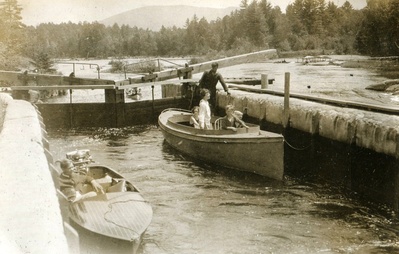 Two boats in the Lower Locks, 1920s. Courtesy of Lynn Newman. Adirondack Daily Enterprise, August 14, 1953
Two boats in the Lower Locks, 1920s. Courtesy of Lynn Newman. Adirondack Daily Enterprise, August 14, 1953
LAKE LOCK JOB BY STATE GETS AID FROM MAIN
The movement to have the State construct a new lock near Bartlett Carry that would connect the Upper and Lower Saranac chain of lakes via Round Lake was further advanced today by Assemblyman Robert G. Main, of Malone.
The Franklin County Board of Supervisors, after passing a resolution urging construction of the lock, contacted the Assemblyman, State Conservation Department Commissioner P. B. Duryea, Senator Paul Graves, State Senator Wheeler Milmoe and Leo Lawrence, chairman of the Conservation Committee.
In a letter to Hayward Plumadore, Harrietstown Supervisor, Mr. Main wrote.
"Relative to your inquiry on the canal and lock matter the situation as follows:
"I spoke to Senator Milmo who, as you know, is the chairman for the Joint Legislative Committee on National Resources for New York State. I explained the situation and he advised the following procedure:
 Postcard
Postcard
Courtesy of Noreen Oslander"That I write to him and give him in detail what the picture is and what this development would mean in the line of benefit to Northern New York and to show how the project would be of benefit not only to people here in Franklin County but to anyone visiting the Adirondacks.
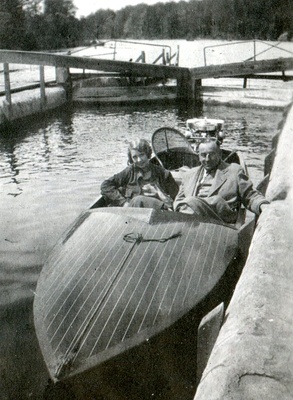 An outboard in the Lower Locks, 1920s. Courtesy of Lynn Newman.
An outboard in the Lower Locks, 1920s. Courtesy of Lynn Newman.
"As soon as Senator Milmo has received a letter from me with the problem outlined he will refer it to his research staff and in all probability, someone from that staff will come up to Saranac Lake and take a look at the situation as it actually exists and he, in turn, will recommend to Milmo's committee to whether or not it was a development which might come within their scope and, if so, would make the necessary recommendations toward the end that the same be developed.
"In our many past conferences on this matter and at the meeting which was held a year ago this spring, I suggested to those attending that they gather together all the data that they possibly could so that I would be able to present the complete picture to the Committee. I feel that those primarily interested in this project should gather that material and get it into my hands as soon as possible and I assure you that as soon as I receive it, I shall do everything that I can to see that this development becomes a reality.
"From what I can discover of this proposed project, it appears to me to be one of benefit to every" one and it would open up the public areas of the Adirondacks which are now accessible to only a few and certainly boat trips through this lake region would offer a look at the Adirondacks and their lakes at their best.
"It seems to me that this project could be self-supporting at least and probably could liquidate its costs over the years and still make the charge reasonable enough so that all of the people could enjoy the regions which it shall open up.
"I know of your sincere interest in this project and know that that interest has continued for a long time. If the information can be collected and forwarded to me, I assure you I will immediately see to it that the same gets into the committee's hands and that some action is taken."
Mr. Plumadore explained today that when Mr. Main mentioned that "this project could be self-supporting" he meant that a small toll might be charged canoeists and boatsmen who used the lock.
"Establishment of this lake improvement would bring Fish Creek within shopping distance of Saranac Lake by boat," Mr. Plumadore added.
External link: Adirondack Daily Enterprise, December 16, 2011, DEC to close lower locks for the winter.


